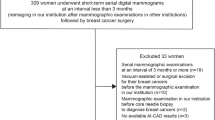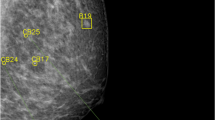Abstract
Objective
To evaluate how breast cancers are depicted by artificial intelligence–based computer-assisted diagnosis (AI-CAD) according to clinical, radiological, and pathological factors.
Materials and methods
From January 2017 to December 2017, 896 patients diagnosed with 930 breast cancers were enrolled in this retrospective study. Commercial AI-CAD was applied to digital mammograms and abnormality scores were obtained. We evaluated the abnormality score according to clinical, radiological, and pathological characteristics. False-negative results were defined by abnormality scores less than 10.
Results
The median abnormality score of 930 breasts was 87.4 (range 0–99). The false-negative rate of AI-CAD was 19.4% (180/930). Cancers with an abnormality score of more than 90 showed a high proportion of palpable lesions, BI-RADS 4c and 5 lesions, cancers presenting as mass with or without microcalcifications and invasive cancers compared with low-scored cancers (all p < 0.001). False-negative cancers were more likely to develop in asymptomatic patients and extremely dense breasts and to be diagnosed as occult breast cancers and DCIS compared to detected cancers.
Conclusion
Breast cancers depicted with high abnormality scores by AI-CAD are associated with higher BI-RADS category, invasive pathology, and higher cancer stage.
Key Points
• High-scored cancers by AI-CAD included a high proportion of BI-RADS 4c and 5 lesions, masses with or without microcalcifications, and cancers with invasive pathology.
• Among invasive cancers, cancers with higher T and N stage and HER2-enriched subtype were depicted with higher abnormality scores by AI-CAD.
• Cancers missed by AI-CAD tended to be in asymptomatic patients and extremely dense breasts and to be diagnosed as occult breast cancers by radiologists.





Similar content being viewed by others
Abbreviations
- AI-CAD :
-
Artificial Intelligence–based computer-assisted diagnosis
- BI-RADS :
-
American College of Radiology Breast Imaging-Reporting and Data System
- DCIS:
-
Ductal carcinoma in situ
- HER2 :
-
Human epidermal growth factor receptor 2
- US :
-
Ultrasound
References
Marmot MG, Altman DG, Cameron DA, Dewar JA, Thompson SG, Wilcox M (2013) The benefits and harms of breast cancer screening: an independent review. Br J Cancer 108:2205–2240
Tabar L, Vitak B, Chen TH et al (2011) Swedish two-county trial: impact of mammographic screening on breast cancer mortality during 3 decades. Radiology 260:658–663
Tabar L, Yen AM, Wu WY et al (2015) Insights from the breast cancer screening trials: how screening affects the natural history of breast cancer and implications for evaluating service screening programs. Breast J 21:13–20
Salim M, Dembrower K, Eklund M, Lindholm P, Strand F (2020) Range of radiologist performance in a population-based screening cohort of 1 million digital mammography examinations. Radiology 297:33–39
Kim H-E, Kim HH, Han B-K et al (2020) Changes in cancer detection and false-positive recall in mammography using artificial intelligence: a retrospective, multireader study. Lancet Digital Health 2:e138–e148
McKinney SM, Sieniek M, Godbole V et al (2020) International evaluation of an AI system for breast cancer screening. Nature 577:89–94
Rodriguez-Ruiz A, Krupinski E, Mordang JJ et al (2019) Detection of breast cancer with mammography: effect of an artificial intelligence support system. Radiology 290:305–314
Benedikt RA, Boatsman JE, Swann CA, Kirkpatrick AD, Toledano AY (2018) Concurrent computer-aided detection improves reading time of digital breast tomosynthesis and maintains interpretation performance in a multireader multicase study. AJR Am J Roentgenol 210:685–694
Rodriguez-Ruiz A, Lang K, Gubern-Merida A et al (2019) Stand-alone artificial intelligence for breast cancer detection in mammography: comparison with 101 radiologists. J Natl Cancer Inst 111:916–922
Schaffter T, Buist DSM, Lee CI et al (2020) Evaluation of combined artificial intelligence and radiologist assessment to interpret screening mammograms. JAMA Netw Open 3:e200265
Gao Y, Geras KJ, Lewin AA, Moy L (2019) New frontiers: an update on computer-aided diagnosis for breast imaging in the age of artificial intelligence. AJR Am J Roentgenol 212:300–307
Erickson BJ, Korfiatis P, Kline TL, Akkus Z, Philbrick K, Weston AD (2018) Deep learning in radiology: does one size fit all? J Am Coll Radiol 15:521–526
Samek W, Wiegand T, Müller K-R (2017) Explainable artificial intelligence: understanding, visualizing and interpreting deep learning models. arXiv preprint arXiv:1708.08296
Baehrens D, Schroeter T, Harmeling S, Kawanabe M, Hansen K, Müller K-R (2010) How to explain individual classification decisions. J Mach Learn Res 11:1803–1831
D’Orsi CJ, Sickles EA, Mendelson EB et al (2013) ACR BI-RADS® Atlas, Breast Imaging Reporting and Data System. Reston, VA, American College of Radiology
Kim EK, Kim HE, Han K et al (2018) Applying data-driven imaging biomarker in mammography for breast cancer screening: preliminary study. Sci Rep 8:2762
Salim M, Wåhlin E, Dembrower K et al (2020) External evaluation of 3 commercial artificial intelligence algorithms for independent assessment of screening mammograms. JAMA Oncol 6:1581–1588
Elias SG, Adams A, Wisner DJ et al (2014) Imaging features of HER2 overexpression in breast cancer: a systematic review and meta-analysis. Cancer Epidemiology Biomarkers &. Prevention 23:1464–1483
Nie Z, Wang J, Ji X-c (2018) Microcalcification-associated breast cancer: HER2-enriched molecular subtype is associated with mammographic features. Br J Radiol 20170942
O'Grady S, Morgan MP (2018) Microcalcifications in breast cancer: from pathophysiology to diagnosis and prognosis. Biochimica et Biophysica Acta (BBA)-Reviews on. Cancer 1869:310–320
Mayo RC, Kent D, Sen LC, Kapoor M, Leung JW, Watanabe AT (2019) Reduction of false-positive markings on mammograms: a retrospective comparison study using an artificial intelligence-based CAD. J Digit Imaging 32:618–624
Lee SE, Han K, Kim E-K (2021) Application of artificial intelligence–based computer-assisted diagnosis on synthetic mammograms from breast tomosynthesis: comparison with digital mammograms. Eur Radiol. https://doi.org/10.1007/s00330-021-07796-y
Funding
The authors state that this work has not received any funding.
Author information
Authors and Affiliations
Corresponding author
Ethics declarations
Guarantor
The scientific guarantor of this publication is Eun-Kyung Kim, MD, PhD.
Conflict of interest
The authors of this manuscript declare no relationships with any companies, whose products or services may be related to the subject matter of the article.
Statistics and biometry
One of the authors has significant statistical expertise.
Informed consent
Written informed consent was waived by the Institutional Review Board.
Ethics approval
Institutional Review Board approval was obtained.
Study subjects or cohorts overlap
Of 896 patients, 192 patients were included in a prior publication that compared diagnostic performance of synthetic and digital mammogram applied by AI-CAD [22]. Lee SE, Han K, Kim E-K (2021) Application of artificial intelligence–based computer-assisted diagnosis on synthetic mammograms from breast tomosynthesis: comparison with digital mammograms. European Radiology. DOI:10.1007/s00330-021-07796-y
Methodology
• retrospective
• cross-sectional study
• performed at one institution
Additional information
Publisher’s note
Springer Nature remains neutral with regard to jurisdictional claims in published maps and institutional affiliations.
Rights and permissions
About this article
Cite this article
Lee, S.E., Han, K., Yoon, J.H. et al. Depiction of breast cancers on digital mammograms by artificial intelligence-based computer-assisted diagnosis according to cancer characteristics. Eur Radiol 32, 7400–7408 (2022). https://doi.org/10.1007/s00330-022-08718-2
Received:
Revised:
Accepted:
Published:
Issue Date:
DOI: https://doi.org/10.1007/s00330-022-08718-2




